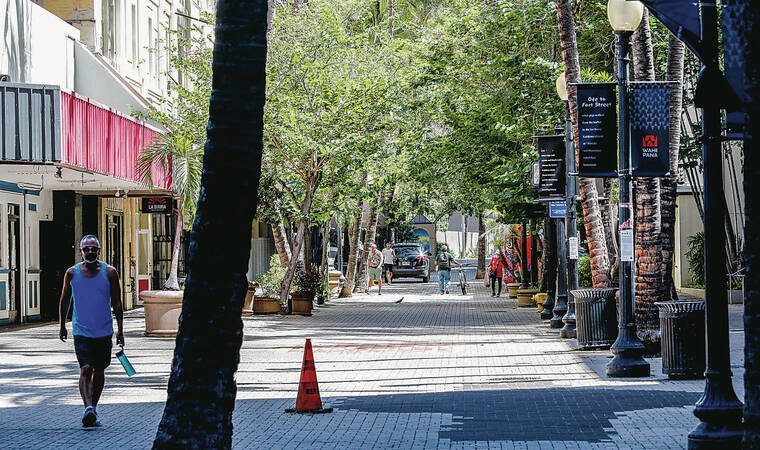By Ian Bauer
Copyright staradvertiser

A proposed revamp to a taxing entity involving downtown Honolulu property owners is being looked at as a way to increase public safety and promote economic revitalization in an area long known for crime, homelessness and shuttered businesses.
Introduced as Bill 51, the City Council measure, if adopted, would rename the existing Fort Street Mall Special Improvement District to the Downtown Honolulu Business Improvement District, or BID.
That action would expand the new district’s boundaries to include an area bordered by Nuuanu Avenue, South
Beretania Street, Richards Street, and Nimitz Highway, the bill indicates. It also would include an adjacent commercial block bounded by Queen, Mililani, Halekauwila and Richards streets.
With an initial term of five years, the new district comes with a management association, governed by either an elected or appointed nonprofit board.
Comprised of up to 20 voting and nonvoting members, the proposed board will include downtown property owners, along with representatives from city agencies, including the Honolulu Police Department, and other community stakeholders, the measure states.
On Sept. 3, the Council voted unanimously to pass Bill 51 on its second of three readings.
The measure is now expected to be referred to the panel’s Zoning and Planning Committee for further review.
“Like the successful Waikiki Business Improvement District, it is hoped that the Downtown Honolulu BID would provide needed serv-ices such as enhanced cleaning, safety patrols, and landscaping, and supplemental improvements like lighting, signage, and street furniture,” a Council news release states. “The Downtown Honolulu BID could also plan and coordinate festivals and other activities to enliven the Downtown Honolulu area.”
Tyler Dos Santos-Tam — whose Council District 6
includes the downtown — sponsored Bill 51 in July.
Under the updated plan, nonresidential property owners in the district would contribute to a $1.9 million “first fiscal year” annual budget through special assessments. These funds, according to Dos Santos-Tam, support a visible safety and maintenance presence seven days a week and help coordinate services with HPD and city agencies.
Residential properties in the district would be exempted from the assessment, the bill indicates.
But prior to the Council’s latest vote, the proposed BID received a mixed response from area interests.
Andrew Pereira, with Pacific Resource Partnership which represents unionized labor statewide, said his group stood in strong support of Bill 51.
“PRP has been a tenant of the Alakea Corporate Tower since 2011, and since that time we’ve seen the ebbs and flows of the condition of downtown Honolulu,” he said. “I think right now with the help of the Blangiardi
administration and the
Caldwell administration preceding that we’re really on an upswing right now.”
Pereira said the BID would “allow us to capitalize even more on the momentum that’s been made.”
Chu Lan Shubert-Kwock, with the Chinatown Business &Community Association, backed the intent of
Bill 51, but wanted the downtown BID to extend into Chinatown.
“We’re not separate, we’re Siamese twins,” she asserted. “So we want to support downtown to prosper, but downtown needs to support Chinatown.”
“Because who doesn’t want cleaner streets, a healthier market, prosperity, and less homeless that are sleeping on our streets,” she said. “So don’t split us into the favorite child and step-child; we want this
A major property owner opposes the BID, however.
“While we have a shared goal of creating a cleaner and safer downtown, we do not believe expanding the Fort Street Mall BID is the most effective approach,” said Kevin Crummy, chief investment officer of California–based Douglas Emmett Management LLC. “When the Fort Street Mall BID was created in 2002, its purpose was to combat severe issues like drug use, drug sales, loitering, assault, petty crime, sanitation, and weirdly, the open contempt for authority.”
“Despite its current budget of $535,000, the issues it was created to solve are still highly visible to anyone walking down the mall,” he said. “It would be irresponsible to expand this model when it has not proven to be effective in its current
Douglas Emmett, he added, believed “a BID strength is providing serv-ices like trash removal, graffiti cleanup and power washing.”
“However, meaningful reductions in homelessness and crime require expertise and authorities of government–led services and the police department,” he said. “A BID simply cannot solve these monumental social issues alone.”
Crummy said his company is also concerned the proposed BID expansion “is being fast-tracked to meet an Oct. 1 real property tax assessment deadline.”
In written testimony, the city administration backed Bill 51.
“As demonstrated by the City and County of Hono-lulu’s thriving relationship with the Waikiki Business Improvement District, a public–private partnership between a community seeking greater ownership over affairs and events of the community delivers positive and tangible results beyond the core services (the city) is able to provide alone,” city Managing Director Mike Formby wrote. “The Blangiardi administration stands in support of this community initiative.”
During Council discussion, Dos Santos-Tam said the proposed BID is “one piece among many different pieces that” the nine–member panel has worked on to revitalize the downtown area and other parts of Oahu.
He also added that “a BID in Chinatown would be a great idea, but we need to get this done first.”
“To the Chinatown folks here I want to say once (the downtown BID) is through we can start the conversation of how we do something like this in Chinatown,” he said. “And make sure that the issues that Chinatown faces is something that the private businesses as well as the residents, and government, can work together on a continued basis to solve (problems).”
Previously, Dos Santos–Tam told the Honolulu Star-Advertiser that there are 2,088 parcels in total within the boundaries of the proposed improvement district, of which 22 are government owned.
“Many of these are condominiumized commercial units within the larger office towers,” he said previously. “Some entities or individuals own multiple properties.”
Larger property owners in the area include the Roman Catholic Church, First Hawaiian Bank, Douglas Emmett, Avalon Development, Meiji Yasuda America Inc. (Pacific Guardian Tower), and Hawaii Pacific University, he noted.
And he suggested a shared use of private security in downtown Honolulu also could be of compelling interest to future members of the district. “Banding together under a BID structure to provide these services they are already paying for may prove to be cost effective in the long run,” he added.
Meanwhile, the Office of the City Clerk has alerted downtown property owners to the planned BID.
In a Sept. 4 letter to the Council, Glen Takahashi reported that pursuant to city law on Aug. 12 his office mailed public hearing notices and special improvement district protest forms to owners and lessees of 1,330 properties as identified by Bill 51.
“The mailing also enabled those persons to protest the establishment of the proposed special improvement district created by the legislation,” Takahashi wrote.
According to city law, proceedings to establish the special improvement district must cease for 90 days if protests are received from either 51% or more of the owners and lessees — greater than 679 owners and lessees; or, more than 51% of the total assessed value of properties proposed to be assessed — greater than $1,249,001,271 in assessed property value.
In this instance, Takahashi noted as of the conclusion of the Council’s Sept. 3 public hearing on Bill 51 the number of protests fell far short — only 88 protest forms were received by the city.
“The aggregated assessed value for the protested properties is $531,377,500,” he wrote.



